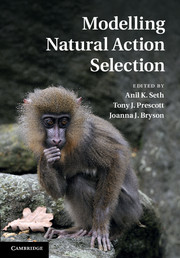Book contents
- Frontmatter
- Contents
- Foreword
- Preface
- Contributors
- 1 General introduction
- Part I Rational and optimal decision making
- 2 Introduction to Part I: rational and optimal decision making
- 3 Do we expect natural selection to produce rational behaviour?
- 4 Optimised agent-based modelling of action selection
- 5 Compromise strategies for action selection
- 6 Extending a biologically inspired model of choice: multi-alternatives, nonlinearity, and value-based multidimensional choice
- 7 Bayesian approaches to modelling action selection
- 8 Post-retrieval inhibition in sequential memory search1
- Part II Computational neuroscience models
- Part III Action selection in social contexts
- Index
- Plate section
- References
2 - Introduction to Part I: rational and optimal decision making
from Part I - Rational and optimal decision making
Published online by Cambridge University Press: 05 November 2011
- Frontmatter
- Contents
- Foreword
- Preface
- Contributors
- 1 General introduction
- Part I Rational and optimal decision making
- 2 Introduction to Part I: rational and optimal decision making
- 3 Do we expect natural selection to produce rational behaviour?
- 4 Optimised agent-based modelling of action selection
- 5 Compromise strategies for action selection
- 6 Extending a biologically inspired model of choice: multi-alternatives, nonlinearity, and value-based multidimensional choice
- 7 Bayesian approaches to modelling action selection
- 8 Post-retrieval inhibition in sequential memory search1
- Part II Computational neuroscience models
- Part III Action selection in social contexts
- Index
- Plate section
- References
Summary
When an animal does one thing rather than another, it is natural to ask ‘why?’ A common explanation is that the action is optimal with respect to some goal. For example, when observing the foraging behaviour of a shorebird, one may ask whether the intake of food is being maximised. This ‘normative’ view, a direct extension of Darwinian principles, has its more recent roots in behavioural ecology (Krebs and Davies, 1997) and optimal foraging theory (Stephens and Krebs, 1986). Adopting a normative perspective on action selection can be very useful in placing constraints on possible underlying mechanisms, for developing and comparing theoretical frameworks relating behaviour to mechanism, and for explaining instances of apparently irrational or suboptimal behaviour. The seven chapters within this section present new insights and modelling results relevant to each of these issues. They also connect with the other parts of this book in important ways. The constraints on underlying mechanisms are thoroughly explored by the computational neuroscience models described in Part II, and patterns of both rational and irrational social behaviour are encountered in a variety of forms in Part III.
Suboptimality and ‘matching’
Assessing animal behaviour from a normative perspective has particular value when observations deviate from predictions, because the scientist is now forced to consider the origin of the apparently suboptimal – or ‘irrational’ – behaviour. In one important example, many animals behave according to Herrnstein's (1961) ‘matching law’, in which responses are allocated in proportion to the reward obtained from each response. However, as both Houston et al. (this volume) and Seth (this volume) note, matching is not always optimal. One response to this observation is to propose that suboptimal matching arises as a side-effect of some underlying principle of behaviour, such as Thorndike's ‘law of effect’, which proposes that behaviour shifts towards alternatives that have higher immediate value (Thorndike, 1911). Another is given by the notion of ecological rationality – that cognitive mechanisms fit the demands of particular ecological niches and may deliver predictably suboptimal behaviour when operating outside these niches (Gigerenzer et al., 1999). In line with ecological rationality, Seth (this volume) shows that simple decision rules that lead to optimal foraging in competitive environments with multiple foragers also lead individual foragers to obey the matching law. The remainder of Seth's chapter describes a novel methodological approach that combines agent-based modelling and optimal/normative approaches via the use of genetic algorithms. The resulting approach, which is given the label ‘optimal agent-based modelling’, achieves the important task of integrating function and mechanism in explanations of action selection (McNamara and Houston, 2009).
- Type
- Chapter
- Information
- Modelling Natural Action Selection , pp. 7 - 11Publisher: Cambridge University PressPrint publication year: 2011

